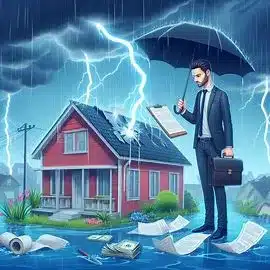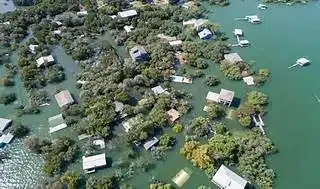Learn How to Successfully File Your Filing Your Storm Damage Insurance Claim Effectively with our comprehensive guide. Discover what’s covered, how to document damage, and file a claim successfully to protect your home after a storm. Get expert tips and insights to ensure you’re prepared for the unexpected.
Outline for the Blog Post: How to Successfully File Your Storm Damage Insurance Claim ?
- Understanding Your Coverage: This section will delve into the specifics of what types of storm damage are generally covered by homeowners insurance, including wind, hail, and lightning damage, while highlighting the importance of knowing the exceptions and limitations of your policy.
- Preparing for a Claim: Offering guidance on preemptive measures homeowners can take before a storm hits, such as documenting the condition of their home and understanding their policy details, to ensure a smoother claims process.
- Documenting the Damage: Steps for thoroughly documenting the damage post-storm with photos and videos, organizing receipts for any immediate repairs, and tips for a comprehensive inventory of affected items.
- Filing the Claim: A step-by-step guide on how to contact your insurance company, what information you’ll need to provide, and the importance of keeping detailed records of all communications and transactions related to the claim.
- Working with an Adjuster and Repairing Your Home: Advice on how to interact effectively with the insurance adjuster, get accurate repair estimates, and select reputable contractors to repair the damage. This section will also touch on navigating disputes and ensuring fair compensation
- No matter where you call home, the threat of a major storm looms large over every household.
- The whims of weather spare no one, often leaving a trail of destruction that can upend lives and livelihoods.
- While we cannot command the clouds or dictate the wind, we can arm ourselves with knowledge and preparation, particularly when it comes to protecting our homes through insurance.
- Homeowners insurance stands as a bulwark against the financial turmoil that storm damage can wreak, offering a semblance of peace in the heart of chaos.
- However, navigating the intricacies of storm damage insurance claims can feel as daunting as the storm itself.
- This guide, “After the Storm: How to Successfully File Your Storm Damage Insurance Claim,” aims to demystify the process, providing you with the knowledge you need to claim what is rightfully yours.
- From understanding your coverage to filing your claim and working with adjusters, we’ll walk you through each step to ensure you’re well-prepared when nature’s fury strikes.

Understanding Your Coverage
Insurance policies can often feel like dense, impenetrable forests of legalese and fine print, especially when it comes to understanding what’s covered under storm damage. Yet, having a solid grasp of your coverage is the cornerstone of a successful insurance claim after a storm. This section demystifies the types of storm damages typically covered by homeowners insurance and emphasizes the importance of knowing the limits and exceptions of your policy.
What’s Usually Covered
- Wind and Hail Damage: This is the most common coverage, addressing damages from high winds and hail. It includes torn shingles, punctured roofs, and broken windows.
- Water Damage: While flood damage requires separate flood insurance, water damage due to rain entering through a wind-damaged roof or window is often covered.
- Lightning Strikes and Power Surges: Damages from lightning, including fire, are typically covered. This also extends to electrical appliances damaged by power surges caused by lightning.
Knowing Your Policy
Understanding the specifics of your policy is crucial. This means knowing your deductible, which is the amount you pay out of pocket before insurance kicks in, and the limits of your coverage. Some policies offer replacement cost coverage (the cost to replace damaged items) versus actual cash value (replacement cost minus depreciation).
Exclusions and Limitations
It’s equally important to know what’s not covered. Standard policies do not cover flood damage from storm surges or overflowing bodies of water. Earth movement (like landslides) triggered by a storm is also typically excluded. Some policies may have specific hail or windstorm deductibles that are higher than the standard deductible.
Tips for Understanding Your Coverage
- Review Your Policy Annually: Needs change, and so does the market value of properties. Ensure your coverage reflects current needs and values.
- Ask Questions: If anything in your policy is unclear, ask your insurance agent for clarification. It’s better to know the ins and outs of your policy before disaster strikes.
- Consider Additional Coverage: If you’re in a high-risk area for floods or earthquakes, consider purchasing additional policies to cover those risks.
Understanding your homeowners insurance coverage is not just about knowing what to do after a storm hits; it’s about being prepared before it happens. Armed with knowledge, you can face the aftermath of a storm with confidence, secure in the knowledge of what your insurance will cover and how to advocate for your needs.
Statistical Data:
- Prevalence of Storm Damage Claims: According to the Insurance Information Institute, wind and hail damage are the most frequent causes of homeowners insurance claims, accounting for over 40% of all home insurance claims in the United States.
- Average Cost of Claims: The National Association of Insurance Commissioners (NAIC) reports that the average claim for wind and hail damage is approximately $10,000, highlighting the significant financial impact of storm damage on homeowners.
- Flood Insurance Statistics: The Federal Emergency Management Agency (FEMA) states that only about 30% of homes in high-risk flood areas have flood insurance. This underscores the gap in protection against flood damage, one of the common consequences of storms.
- Claims Processing Time: A survey conducted by the Consumer Reports National Research Center found that about 20% of insurance claims were not settled within six months, indicating the potential for prolonged claims processes following storm damage.
- Dispute Resolution: The American Bar Association notes that approximately 10% of insurance claims result in a dispute between the policyholder and the insurance company, often requiring mediation, arbitration, or legal action to resolve.
- Impact of Climate Change on Insurance Claims: Research by the Environmental Defense Fund suggests that the frequency and severity of storms and related natural disasters are increasing due to climate change, leading to a projected rise in insurance claims and premiums in affected areas.
Disclaimer for Statistical Data:
The statistical data provided in this article are for informational purposes only and are subject to change. These statistics have been gathered from various sources, including the Insurance Information Institute, the National Association of Insurance Commissioners (NAIC), the Federal Emergency Management Agency (FEMA), the Consumer Reports National Research Center, the American Bar Association, and the Environmental Defense Fund. While we strive to present the most current and accurate information, please be aware that the figures mentioned may vary due to new research, updates in data, and changes in the insurance industry’s practices and policies. Readers are encouraged to conduct their own research and consult with insurance professionals for the most up-to-date information and advice specific to their situation.

The average cost of flood insurance in the United States is $739 per year, based on the 2023 National Flood Insurance Program rates. However, this figure does not include private flood insurance policies from companies that aren’t backed by the NFIP.
Keep in mind that the actual cost can vary significantly based on several factors, including:
- Location of your house: Areas with higher flood risk may have higher premiums.
- Size and structural strength of your house: Larger homes or those with specific vulnerabilities might impact the cost.
- Risk of floods in your locality: If your area is prone to flooding, it could affect the premium.
For more accurate pricing, consider obtaining a quote from a flood insurance provider. Remember that investing in flood insurance can provide peace of mind and financial protection in case of unexpected floods
To determine if your home is in a flood zone, you can follow these steps:
- Realtor.com Flood Risk Tool:
- A good starting point is the Realtor.com flood risk tool. It connects you directly to the Federal Emergency Management Agency (FEMA) site.
- Enter your property’s address, and you’ll see a map showing flood zones in the area.
- FEMA has several flood zone classifications based on the estimated frequency of storms that could cause flooding:
- High-risk zones (Special Flood Hazard Areas) have a 1% annual chance of flooding (also known as the base flood or 100-year flood).
- Moderate flood zones are labeled with a B or X and reflect a 0.2% annual chance of a flood (considered a 500-year flood).
- Lowest-risk areas are labeled with a C or X and are outside the SFHA zones, situated at higher elevations.
- Redfin:
- Visit the Federal Emergency Management Agency (FEMA) Flood Map Service Center.
- Type in your property’s address, and a map showing its flood zone will appear.
- Local Council Flood Maps:
- Check with your local council. Most councils have publicly available flood maps that include historical data from previous flooding events and flood risk modeling.
Remember that while FEMA flood maps are a trusted resource, some of them may be outdated. To address this, the Realtor.com flood risk tool also incorporates data from Flood Factor, which provides a more comprehensive view of a property’s flood risk. Stay informed and take necessary precautions to protect your home from potential flooding.

The main difference between homeowners insurance and flood insurance lies in what they cover:
- Homeowners Insurance:
- Coverage: Homeowners insurance typically covers damages caused by various events, including fire, theft, and some natural disasters.
- Common Scenarios Covered:
- Fire damage: If your home catches fire, your homeowners policy should provide coverage.
- Theft: Stolen belongings are usually covered.
- Certain natural disasters: Some policies include coverage for events like windstorms or lightning strikes.
- Exclusions: However, homeowners insurance does not cover flood damage.
- Purpose: It safeguards your home against a range of risks but does not specifically address flooding.
- Flood Insurance:
- Coverage: Flood insurance is specifically designed to protect your home and personal property from damages caused by flooding.
- What It Covers:
- Flood-related damage: This includes damage due to heavy rainfall, overflowing rivers, hurricanes, and other flood-related events.
- Separate Policy: It is separate from a homeowners insurance policy.
- Importance: If your home is in an area prone to water damage (such as melting snow, heavy rains, or wildfires), adding flood insurance can provide an extra layer of protection.
FAQs: Filing Your Storm Damage Insurance Claim Effectively
Does home insurance cover Filing Your Storm Damage Insurance Claim Effectively ?
Most homeowners insurance policies cover various types of storm damage. However, the cause of the damage may make a difference. Here are some common storm-related damages that are typically covered:
Water and ice damage: Rain, ice, snow, and hail damage are often covered. For instance, if heavy winds rip off your roof, allowing rain to damage the inside of your home, your policy likely covers it.
Wind and hail: Strong winds that rip shingles off your roof or send a tree crashing into your living room are usually covered. Wind damage leading to water damage inside your home is also likely covered.
Lightning strikes and power surges: Damage resulting from lightning strikes, fire, smoke, or power surges is often covered, especially if it’s sudden and accidental.
What about flooding?
Standard homeowners insurance does not cover flood damage. Whether caused by heavy rainfall, snowmelt, overflowing rivers, or hurricanes, flood damage is usually not covered. To protect against floods, consider purchasing flood insurance through the National Flood Insurance Program (NFIP) or private insurers like Kin.
Does homeowners insurance cover roof damage?
Yes, homeowners insurance typically covers roof damage caused by storms. If strong winds or hail damage your roof, your policy should kick in. However, gradual wear and tear over time are usually excluded.
How to Successfully File Your Storm Damage Insurance Claim ?
Here are the steps to follow:
Document the damage: Take photos and videos of the affected areas.
Contact your insurance company: Call the claims number on your policy or find the 800 number online. Many insurers have 24-hour claims hotlines.
Make minor repairs: Prevent further damage by making minor repairs.
Work with the insurance adjuster: Get quotes for repairs and collaborate with the adjuster to assess the damage.
Conclusion: Filing Your Storm Damage Insurance Claim Effectively
When storms strike, understanding your insurance coverage and promptly filing a claim can make a significant difference. Remember to document the damage, contact your insurer, and take necessary steps to mitigate further harm. By following these guidelines, you’ll be better prepared to navigate storm damage insurance claims and protect your home
